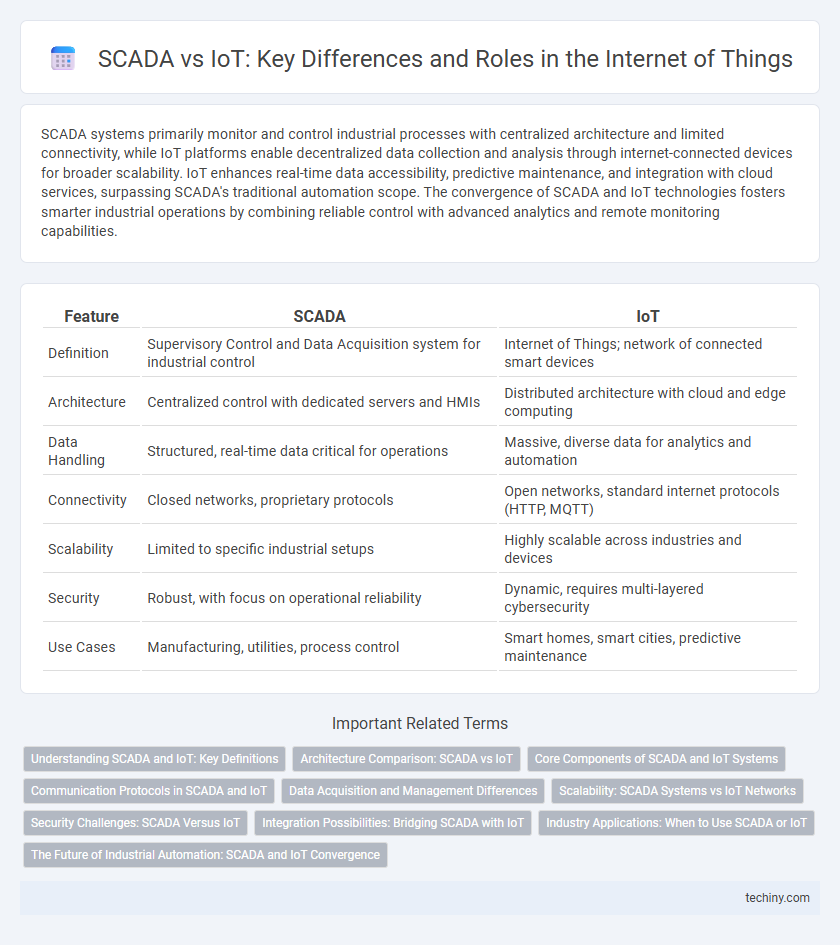SCADA systems primarily monitor and control industrial processes with centralized architecture and limited connectivity, while IoT platforms enable decentralized data collection and analysis through internet-connected devices for broader scalability. IoT enhances real-time data accessibility, predictive maintenance, and integration with cloud services, surpassing SCADA's traditional automation scope. The convergence of SCADA and IoT technologies fosters smarter industrial operations by combining reliable control with advanced analytics and remote monitoring capabilities.
Table of Comparison
| Feature | SCADA | IoT |
|---|---|---|
| Definition | Supervisory Control and Data Acquisition system for industrial control | Internet of Things; network of connected smart devices |
| Architecture | Centralized control with dedicated servers and HMIs | Distributed architecture with cloud and edge computing |
| Data Handling | Structured, real-time data critical for operations | Massive, diverse data for analytics and automation |
| Connectivity | Closed networks, proprietary protocols | Open networks, standard internet protocols (HTTP, MQTT) |
| Scalability | Limited to specific industrial setups | Highly scalable across industries and devices |
| Security | Robust, with focus on operational reliability | Dynamic, requires multi-layered cybersecurity |
| Use Cases | Manufacturing, utilities, process control | Smart homes, smart cities, predictive maintenance |
Understanding SCADA and IoT: Key Definitions
SCADA (Supervisory Control and Data Acquisition) systems are industrial control systems used for monitoring and controlling infrastructure and facility-based processes through centralized software and hardware. IoT (Internet of Things) refers to the network of interconnected devices embedded with sensors, software, and other technologies to collect and exchange data over the internet. SCADA focuses on real-time operational control within specific industrial environments, while IoT emphasizes broad connectivity and data analytics across diverse applications and industries.
Architecture Comparison: SCADA vs IoT
SCADA architecture relies on centralized control systems connected to field devices through dedicated communication networks, prioritizing reliability and real-time monitoring mainly within industrial environments. IoT architecture uses distributed, cloud-based platforms integrating diverse sensors and devices via the internet, enabling scalable data analytics and remote management. The key difference lies in SCADA's hierarchical and closed system design versus IoT's open, flexible, and interconnected framework supporting broader application domains.
Core Components of SCADA and IoT Systems
SCADA systems primarily consist of programmable logic controllers (PLCs), human-machine interfaces (HMIs), and supervisory computers that monitor and control industrial processes with real-time data acquisition. IoT systems integrate sensors, cloud computing platforms, and edge devices to enable scalable, interconnected networks for data collection, analysis, and remote management. While SCADA focuses on localized control and automation within industrial environments, IoT expands connectivity across diverse devices and applications through advanced networking and analytics.
Communication Protocols in SCADA and IoT
SCADA systems primarily utilize proprietary and specialized communication protocols such as Modbus, DNP3, and OPC to ensure reliable and secure data transmission within industrial environments. In contrast, IoT solutions leverage standardized internet protocols like MQTT, CoAP, and HTTP, enabling seamless interoperability and scalability across heterogeneous devices and cloud platforms. The shift from SCADA protocols to IoT protocols facilitates real-time data analytics and remote monitoring through efficient, lightweight, and IP-based communication methods.
Data Acquisition and Management Differences
SCADA systems rely on centralized data acquisition with predefined protocols for monitoring and controlling industrial processes, emphasizing real-time control and operational reliability. In contrast, IoT platforms utilize distributed sensor networks collecting diverse data types, enabling scalable and flexible data management through cloud-based analytics and edge computing. IoT's data acquisition supports broader interoperability and advanced insights by integrating heterogeneous devices, whereas SCADA focuses on critical infrastructure with deterministic data handling.
Scalability: SCADA Systems vs IoT Networks
SCADA systems typically face limitations in scalability due to their reliance on centralized architectures and proprietary protocols, which restrict the number of connected devices and data throughput. In contrast, IoT networks leverage cloud computing and standardized communication protocols, enabling seamless expansion to millions of heterogeneous devices across diverse geographical locations. This scalability advantage allows IoT platforms to support dynamic, large-scale applications such as smart cities, industrial automation, and real-time analytics more efficiently than traditional SCADA systems.
Security Challenges: SCADA Versus IoT
SCADA systems traditionally rely on closed, proprietary networks with fixed endpoints, offering a controlled environment but limited adaptability to evolving cyber threats. IoT environments introduce a vast array of connected devices across diverse networks, significantly expanding the attack surface and increasing vulnerability to breaches, data interception, and unauthorized access. The differing security paradigms highlight SCADA's resilience in critical infrastructure contrasted with IoT's urgent need for scalable, dynamic security protocols incorporating encryption, authentication, and real-time threat detection.
Integration Possibilities: Bridging SCADA with IoT
Bridging SCADA systems with IoT platforms enhances real-time data acquisition and predictive analytics by integrating industrial control with cloud-based intelligence. Leveraging IoT enables remote monitoring and advanced visualization of SCADA data through scalable, interoperable protocols like MQTT and OPC UA. This integration transforms traditional SCADA environments into flexible, connected ecosystems that support automation, improved decision-making, and asset optimization.
Industry Applications: When to Use SCADA or IoT
SCADA systems excel in industrial environments requiring real-time monitoring and control of critical infrastructure, such as power plants and manufacturing lines, due to their reliability and deterministic performance. IoT offers scalable connectivity and advanced data analytics for industries seeking predictive maintenance, asset tracking, and enhanced operational insights across distributed locations. Choosing between SCADA and IoT depends on the specific industry application, with SCADA preferred for mission-critical control and IoT suited for data-driven optimization and remote monitoring.
The Future of Industrial Automation: SCADA and IoT Convergence
The future of industrial automation hinges on the convergence of SCADA systems with IoT technologies, enabling enhanced real-time data insights and predictive maintenance capabilities. IoT expands SCADA's traditional supervisory control by incorporating advanced sensors, edge computing, and cloud connectivity, driving operational efficiency and reducing downtime. This integration fosters smarter decision-making and scalable industrial ecosystems by leveraging big data analytics and AI-driven automation.
SCADA vs IoT Infographic

 techiny.com
techiny.com